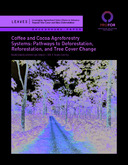Mostrar el registro sencillo del ítem
Coffee and Cocoa Agroforestry Systems: Pathways to Deforestation, Reforestation, and Tree Cover Change
| dc.contributor.author | Somarriba, Eduardo | |
| dc.contributor.author | López Sampson, Arlene | |
| dc.date.accessioned | 2019-04-08T21:33:24Z | |
| dc.date.available | 2019-04-08T21:33:24Z | |
| dc.date.issued | 2018 | |
| dc.identifier.uri | https://repositorio.catie.ac.cr/handle/11554/9035 | |
| dc.description.abstract | Coffee cultivation covers 11 million hectares and involves 10 million farmers producing 22 million tons of green coffee annually. Coffee production influences the livelihoods of some 125 million people. Cocoa cultivation covers 10.2 million hectares and involves 10 million cocoa farmers producing 4.47 million tons annually. Cocoa production influences the livelihoods of some 40-50 million people. Globally, 48% of coffee and 31% of cocoa is cultivated under shade in agroforest systems. Coffee and cocoa are cultivated mainly by smallholder farmers. Coffee and cocoa are drivers of both deforestation and reforestation. In the last two centuries, coffee production was responsible for dramatically transforming the landscape of the highlands in the New World by displacing sugarcane, cattle, and other minor crops as well as by displacing natural forests. In the last five decades, the expansion of cocoa cultivation led to the disappearance of 14–15 million hectares (ha) of tropical forests globally. Coffee and cocoa plantations may be established following four different pathways. (Figure 1) Transition pathways are not linear either in time or in space. | es_ES |
| dc.language.iso | en | es_ES |
| dc.publisher | The World Banki (Washington D.C.) USA | es_ES |
| dc.rights | info:eu-repo/semantics/openAccess | es_ES |
| dc.title | Coffee and Cocoa Agroforestry Systems: Pathways to Deforestation, Reforestation, and Tree Cover Change | es_ES |
| dc.type | Libro | es_ES |
Ficheros en el ítem
Este ítem aparece en la(s) siguiente(s) colección(ones)
-
Publicaciones y documentos [4419]


